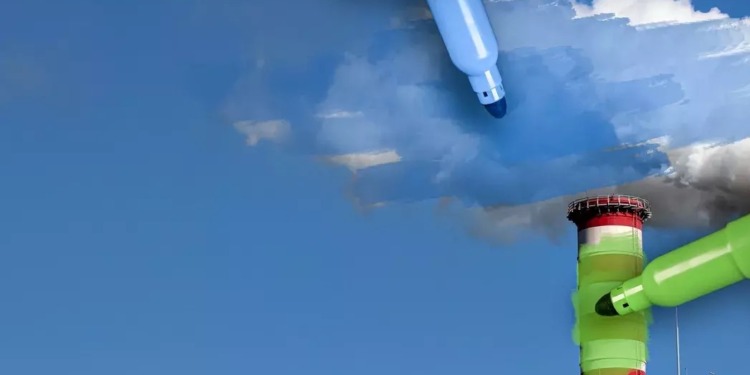Greenwashing is always on our radar. Cleansing retail of misleading marketing that fills your shopping carts with greenwashed items is part of the reason why the Impakter marketplace got its start. The fashion industry is the largest plastic polluter in retail, so it’s no wonder that it’s hard to spot greenwashing signs when we see them. But if you’re not shopping eco marketplaces certified by EU and global standards, don’t worry.
Here’s how to spot greenwashing before you waste your money.
1- How is a company greenwashing, anyway?
Greenwashing is when companies brandish products that are produced according to green initiatives. Reduced waste, circular economy, and organic, recycled, and natural materials are some of the keywords for greenwashing examples for consumers to watch out for. The Merriam-Webster dictionary defines greenwashing as “the act or practice of making a product, policy, activity, etc. appear to be more environmentally friendly or less environmentally damaging than it really is.” While this seems simple enough, it comes with a plethora of hidden dangers.
There’s nothing worse than giving companies your hard-earned cash based on misleading or even false claims. The fashion industry has a huge environmental impact, particularly from all the textile waste that it produces and piles into landfills.
When you’re looking for ways to contribute to environmental benefits in the new year, what you wear is a major place to start. But when companies falsely claim to have full sustainability, from production to manufacturing, it’s hard for consumers to know whether or not they’re only contributing to more pollution from a fast fashion product.
2- Don’t fall for the trap: know how to protect yourself
Flashing a green thumb is a persuasive marketing tool.
Sometimes companies can saturate themselves with their green ideologies…and back them up with no action whatsoever. Some greenwashing signs come from brands that lack certifications to back up their claims even if their website features an extensive sustainable, circular design strategy.
What good is it if ECOCERT or OEKO-TEX isn’t there to say this process actually makes a difference? And that’s if the brand is conducting ethical manufacturing at all!
2- Greenwashing signs on the consumers’ label
Your Spidey senses should go on high alert if you turn a shirt inside out and a descriptive label is nowhere to be found. A brand that doesn’t employ greenwashing strategies has no reason to hide the materials in that shirt.
If the product truly lacks harmful textiles like polyurethane, then companies will showcase that loud and clear on the neckline tag next to the “do not machine dry” warning.
How To Spot Greenwashing:
1. Is it a corporation?
↳ If yes, proceed to 2.2. Is it Patagonia or Ben & Jerry’s?
↳ If no, it’s greenwashing!!Okay, that’s an exaggeration — but not much of one.https://t.co/wcvA1fUdjS
— Sheldon Whitehouse (@SenWhitehouse) January 5, 2023
3- Walk don’t run from plastic packaging: greenwashing products
You should raise an eyebrow if you open an online-ordered outfit and it’s wrapped in a hard plastic container–and choked in an air-sealed, shiny plastic square. Not only are those materials difficult to recycle, but they also contribute to gas-emitting landfills and sea pollution that chokes turtles and fish.
It’s a greenwashing sign (and a glaring trait of fast fashion) to utilize harmful plastic packaging because it’s an easy way of manufacturing.
Related Articles: Is Uniqlo as sustainable as it claims? |Are Gucci and Louis Vuitton greenwashing? | Is Hugo Boss sustainable? Sort of!
For some of the top 10 greenwashing companies like Shein, once it’s on your doorstep, the sale is out of sight, out of mind–which leaves you to pick up the pieces. Greenwashing examples come in unexpected ways, especially when a company claims to be sustainable. You don’t want to be responsible for plastic consumption you never signed up for, do you? Don’t be a greenwashing sinner like many brands!
4- Silent but deadly: look for companies’ hidden labels
Sometimes the problem isn’t in the lack of labels, but the label itself. If you have to squint to read the materials listed on a shirt’s tag, chances are that something is there that you shouldn’t see.
Sure, self-proclaimed sustainable companies like BooHoo and Mango have made great strides.
#BoohoobyKourtneyKardashian got to the runways at #NYFW in order to prove sustainable fashion can be stylish. However, many critics are frustrated following the discovery of polyurethane in the collection.
Read our latest #ecolife article
https://t.co/PYc16ybohG
— IMPAKTER ECO (@Impaktereco) September 16, 2022
But they have yet to brandish that sustainable title with a clear conscience because polyurethane is nestled among the list of materials–right alongside recycled cotton and polyester.
Polyurethane, a non-compostable substance that fills landfills and clogs the atmosphere with harmful gasses, has no place next to the recycled materials list. Polyurethane also has no business living in the clothing of a so-called eco-friendly brand.
This is a greenwashing example; if a brand showcases all the right goals, flaunts all the right certifications, and even hides a substance like polyurethane alongside eco materials, how is the average shopper supposed to identify the greenwashing strategies?
Now that you know how to spot greenwashing signs, it’s time to act!
Brands bank on the hope that their customers don’t do their research before spending their money. Brands like Chanel, Gucci, and Louis Vuitton, have often struggled to back their words with facts. H&M has probably become the most famous greenwashing firm in the world.
This is why we do the digging so you don’t have to.
Don’t let household name companies get the better of you anymore. In 2023, cleanse your carts of greenwashing examples once and for all.
Editors Note: The opinions expressed here by the authors are their own, not those of Impakter.com — In the Featured Photo: A shopper holding paper shopping bags. Featured Photo Credit: Jacek Dylag/Unsplash.









